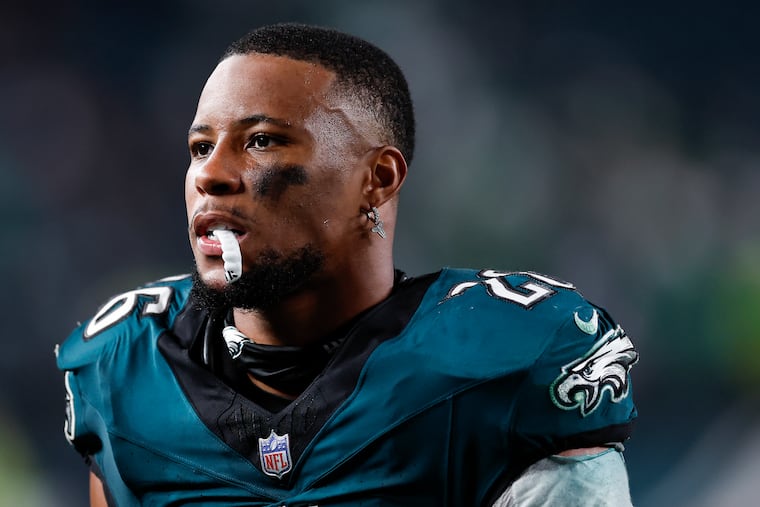Three Eagles myths: Saquon’s drops, Sirianni’s decisions, Hurts’ progress
Here's a counterargument to three pieces of criticism about the Eagles heading into Week 3.

Parsing the points, tackling the takes, and evaluating the opinions about the Eagles heading into Week 3 ...
Myth: Nick Sirianni’s decision to throw the ball on third-and-3 was even worse, given Saquon Barkley’s history of drops.
It’s true that Barkley leads all NFL running backs in drops since 2021, which is something I did not realize before somebody raised it in the aftermath of the Eagles’ last-minute loss to the Atlanta Falcons on Monday. But after digging a little deeper into the numbers, I don’t see any evidence that Barkley’s hands should factor into the Eagles’ play-calling decisions.
Keep in mind, Barkley ranks in the top five among NFL running backs in targets since 2021. So he has more opportunities for drops than the average back. We have to look at the rate at which he drops passes. It’s still higher than most pass-catching backs, but not significantly so.
His 8.5 drops per 100 chances are 0.6 more than Breece Hall, 1.2 more than Austin Ekeler, 1.6 more than Aaron Jones, and 1.8 more than Alvin Kamara. Even on the higher end of that spectrum, Barkley averages about one additional drop per season. Ideal? No. But it’s nowhere close to being a legitimate consideration when calling plays or deciding personnel groups.
Keep in mind, Barkley’s average depth of target ranks second behind only Christian McCaffrey among backs with at least 120 targets since 2021. So comparing him to other running backs isn’t necessarily apples-to-apples. The Eagles are not expecting him to be McCaffrey, who is a freak (six drops since 2021, including none last year).
» READ MORE: Vic Fangio needs to fix his worst-in-NFL unit. Fast.
Myth: Sirianni’s decision to kick a field goal to go up six on fourth-and-2 from the Falcons 10-yard-line wasn’t just debatable: It was wrong and worthy of ridicule.
It’s perfectly fair to argue that Sirianni should have gone for it on fourth down because that is what the math said to do. What’s unfair is pretending that kicking the field goal was a uniquely and glaringly boneheaded decision for an NFL coach to make.
In fact, over the last 24 seasons, no coach has made the decision that people suggest Sirianni obviously should have made. All 20 of them elected to kick the field goal to go up by at least four points rather than going for it on fourth-and-short inside the red zone in the closing minutes of the game.
» READ MORE: Nick Sirianni has been defiant since that awful Eagles loss. If he’s not careful, it could cost him his job.
This, according to Pro-Football-Reference.com’s Play Index.
Here were my exact search parameters:
Leading by 1-4 points.
Needing 2 to 4 yards for a first down (i.e., fourth-and-short but not QB sneakable).
Ball between the opponent’s 20-yard-line and 5-yard-line.
Time remaining between 2:00 and 0:20 in the fourth quarter.
Again, there were 20 situations that fit this criteria between 2001 and 2024. In all 20, the coach kicked the field goal. Not a single one of them made the “correct” decision to go for it. And in 19 of the 20 cases, the team ended up winning the game. The lone exception before the Eagles’ 22-21 loss was the Texans in 2011.
Leading the Colts, 13-12, with two minutes left, Houston opted for a 31-yard field goal on fourth-and-2 from the Indy 13-yard-line to go up four points. On the ensuing drive, Dan Orlovsky drove the Colts 77 yards in 1 minute, 26 seconds before throwing a 1-yard touchdown pass to Reggie Wayne to win, 19-16.
Look, I’m a numbers guy. You play the probabilities when they are heavily in your favor. But this was a virtual coin flip. It’s like hitting a hard 16 when the dealer is showing a face card. The math says it gives you a slight advantage. Mostly, though, the math says it doesn’t really matter what you choose.
» READ MORE: Eagles vs. Falcons film review: Areas of improvement for the league’s worst run defense
People are making fun of Sirianni for claiming that he did his own analytics study. But, look, it’s not completely irrelevant that 19 of 20 teams won the game when they kicked the field goal. The math may have said it was a marginally suboptimal decision. It hardly was catastrophic.
Myth: Jalen Hurts’ play has been problematic.
Take a look around the NFL and stop wringing your hands. Have we seen Hurts play better? Sure. Does he need to clean some things up? Absolutely. Does he look as comfortable and dynamic as he did in the Super Bowl? No, he doesn’t. But Hurts has been a heck of a lot better than the baseline level of NFL quarterback performance this season. The criticism after Week 1 was valid. In Week 2, he was pretty darn good.
The Eagles’ first touchdown drive was all Hurts: an 18-yard pass to DeVonta Smith, a 23-yard scramble on fourth-and-3, a 15-yard scramble on third-and-11, a 7-yard touchdown pass to Smith. That was as encouraging a sequence as we’ve seen from Hurts since last season’s win over the Bills.
Through two weeks, Hurts has thrown for more yards than Patrick Mahomes, Joe Burrow, and Josh Allen. He ranks sixth in the NFL in pass success rate and seventh in QBR. The Eagles rank in the top five in the NFL in yards-per-drive and time-of-possession per drive. They’ve scored on 50% of their possessions, which ranks sixth.
With even an average NFL defense, the Eagles would be 2-0 with wins over teams who many expected to contend for the playoffs. I don’t disagree with a lot of the criticism I’ve heard. It’s just missing a lot of context.
» READ MORE: Eagles desperately need more from Bryce Huff, their biggest Week 1 bust since Ricky Watters